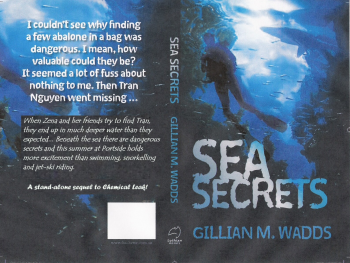Sea Secrets Teachers’ Notes

a.practical.exercise
Mapping and observation.
Maps, researching information, rules, use of Marine Sanctuaries.
Computer or library research.
Marine Sanctuaries: Marine Sanctuaries have been declared in Port Phillip Bay and many other places along the Australian coastline.
- Find out where the Marine Sanctuaries are in your state or territory.
- Draw or copy a map of your state or territory and mark in the Marine Sanctuaries.
- What are the rules in a Marine Sanctuary? What are you allowed to do and what are you NOT allowed to do?
- Design your own logo for a T-shirt or a poster to advertise one of the Marine Sanctuaries in your state.
- Why are Marine Sanctuaries valuable?
- You can go to www.seapics.com.au or email David Bryant at seapics@alphalink.com.au to purchase underwater photographs or DVDs to illustrate the wide range of sea-life in Victorian waters.
.national.parks
National Parks: Apart from protecting marine life, government agencies also protect the land and the creatures that live there by declaring National Parks. If your school is not near the coast, it may be valuable to research National Parks.
- Find out where the National Parks are in your region.
- Draw or copy a map of your state and mark in your region and (number) National Parks.
- What are the rules in a National Park? What are you allowed to do and what are you NOT allowed to do?
- Design your own logo for a T-shirt or a poster to advertise one of the National Parks in your region.
- Why are National Parks valuable?
.conservation
A Class Activity or Student Research
Type “Earthkids” into a search engine. This will take you to the Australian Conservation Foundation website. Membership can be individual or group.
- There is a regular newsletter
- Volunteers are encouraged to work on various projects.
- A class could research a local conservation group and become involved in community activities.
- There are many activities suggested on this site, either individual or group.
.where.do.you.come.from?
Family backgrounds.
There are a number of different national backgrounds in the characters in Sea Secrets.
The following exercise is from the Teacher Notes to Chemical Leak! and can be used as a Classroom Activity or Student Assignment in relation to Sea Secrets.
A Classroom Activity or Student Assignment:
- How many different backgrounds are present in your class?
- How many generations have lived in Australia?
- Mark countries of origin on a map of the world.
- Research with parents, grandparents and other relatives to discover your history. (When your family first arrived in Australia, why they migrated, etc.)
- Find out something about the country (or countries) your family originally came from.
.immigration.and.refugees
History, Geography, Research.
Some of the newest arrivals in Australia come to the country because they are escaping from poverty or persecution or for other reasons.
- What is a migrant? What is a refugee? What is an asylum seeker? What is an indigenous inhabitant?
- What country do you think Tran came from? How might he have travelled here?
- Why do you think Tran’s mother doesn’t speak very much English?
- From all the countries of the world, choose a country and research why a family (or a person) might have wanted to come to Australia.
.writing.about.animals
In Sea Secrets, Zena is suddenly frightened by a “watch-cocky” which screams at her and alerts the people in the house.
Think about what other animals might be good to use as “watch-dogs” or protectors of a property.
Write a story about an animal which either:
- saves a life
- protects a child
- foils a robbery
- calls for help
Don’t forget to describe the animal – what is it?
Describe how it looks (size, colour, fur/feathers, eyes).
Is it friendly, frightened, fierce, sad, happy?
Does it love its owner? Why?
Your story can be funny or serious.
It can have a happy ending or a sad one.